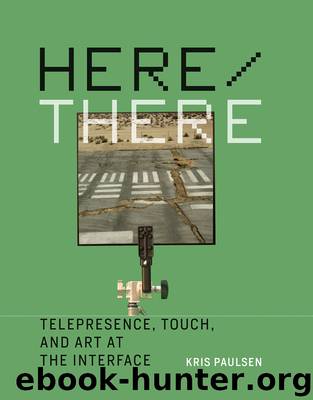HereThere by Paulsen Kris;

Author:Paulsen, Kris;
Language: eng
Format: epub
Publisher: MIT Press
Published: 2017-03-01T05:00:00+00:00
Our World, Their World
By 1968, the year television audiences saw Apollo 8’s live images of Earth, 768 rockets had traveled to Earth’s orbit or beyond, and 2,011 satellites were already circling the planet.8 Since Sputnik’s launch in 1957, the United States and the Soviet Union had been eagerly catapulting remote sensing devices into Earth’s orbit. The Russians began the space race with Sputnik 1. For three weeks, the small, polished sphere broadcast radio pulses from the ionosphere to anxious listeners below.9 The United States quickly followed with Explorer 1 in early 1958. In 1962 and 1963, the United States placed into orbit its first two telecommunications satellites, Telstar 1 and Telstar 2. Video could now be bounced from the ground into space and onto television sets across the globe. If Sputnik’s launch indicated that man had begun to conquer space, creating an object that could briefly colonize a small swath of the cosmos, Telstar, and the other telecommunication satellites that soon followed, demonstrated man’s conquest of time: the new technology enabled instantaneous, real-time audio and visual contact between distant sites, joining them in a simultaneous “now.”10
Humankind’s sudden mastery of both space and time was put on display in the mid-1960s in a series of what media theorist Lisa Parks calls “satellite spectaculars,” live television events that illustrated the power of satellite telecommunications to connect far-flung people and places.11 Most notable of these programs was 1967’s Our World, a two-hour program aimed at “global” coverage rather than merely linking North America with Western Europe. The Telstar and Intelsat satellites linked the US with Europe; Syncom connected East Asia, and ATS-1 brought Australia into the “global” network of satellite telecommunication. In its own terms, Our World demonstrated this technologically (and militaristically) enabled “global unity.” However, as Parks describes in her close analysis of the show, Our World in fact did just the opposite: it highlighted how the fantasy of a “global present” as enabled by satellite technology was steeped in “Western discourses of modernization, global unity, and planetary control.”12 While claiming to create a utopian, McLuhanesque “global village” by using satellites to link geographically and culturally separated places and peoples, Our World actually “divided the world once again” by emphasizing the difference between life in the various hemispheres, and making it clear that the “industrialized” and “free” North and West stood against the “hungry” and “developing” South and East.13 That is, while bringing together some 500 million viewers from 30 nations, Our World dramatized distance, difference, and otherness by means of the technology that only a few countries had.14
The program began with grand utopian gestures—the Vienna Boys’ Choir sang the theme song in scores of languages, and the first segment featured a series of infants, born within minutes of one another, in places as far-flung as Japan, Denmark, Mexico, and Canada. Although the babies were born nearly simultaneously, they inhabited different earthly times. The Danish child was born on the date before her Japanese counterpart, for the time zones that demarked the
Download
This site does not store any files on its server. We only index and link to content provided by other sites. Please contact the content providers to delete copyright contents if any and email us, we'll remove relevant links or contents immediately.
Learning SQL by Alan Beaulieu(6237)
Weapons of Math Destruction by Cathy O'Neil(6214)
Digital Minimalism by Cal Newport;(5704)
iGen by Jean M. Twenge(5385)
Sapiens by Yuval Noah Harari(5322)
The Age of Surveillance Capitalism by Shoshana Zuboff(4243)
Elon Musk by Ashlee Vance(4084)
Thing Explainer by Randall Munroe(3909)
Apollo 8 by Jeffrey Kluger(3667)
Future Crimes by Marc Goodman(3562)
The Science Book (Big Ideas Simply Explained) by DK(3252)
Who Can You Trust? by Rachel Botsman(3110)
The Innovators: How a Group of Hackers, Geniuses, and Geeks Created the Digital Revolution by Walter Isaacson(2993)
I Live in the Future & Here's How It Works by Nick Bilton(2960)
Infinite Energy Technologies by Finley Eversole(2952)
Steve Jobs by Walter Isaacson(2857)
Dawn of the New Everything by Jaron Lanier(2751)
Chernobyl by Serhii Plokhy(2514)
Ben Franklin's Almanac by Candace Fleming(2492)
